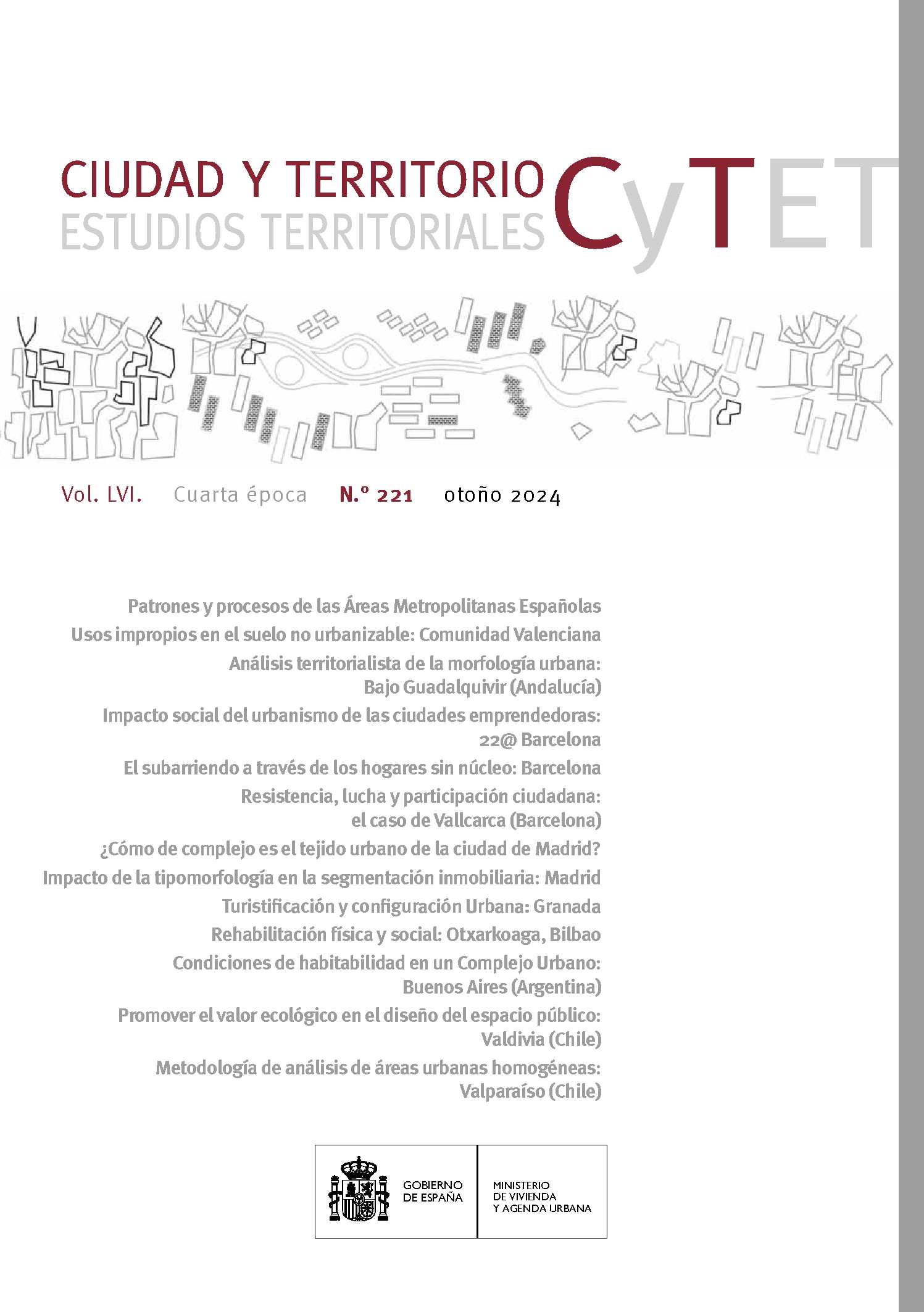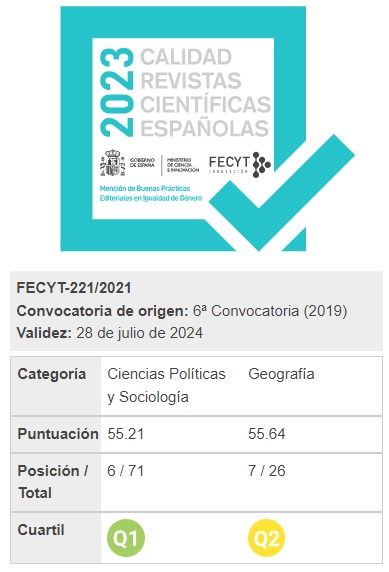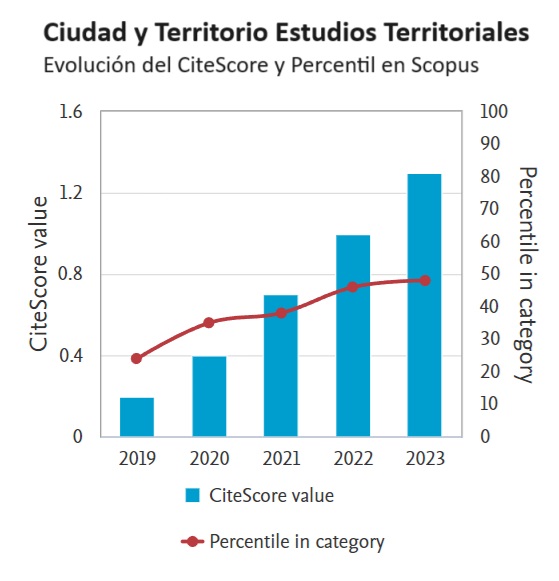Territorialist analysis of urban morphology for a polycentric and balanced development of the territory of the lower Guadalquivir
DOI:
https://doi.org/10.37230/CyTET.2024.221.3Keywords:
Morphotypological analysis, Settlement systems, Lower Guadalquivir, Italian territorialist school, PolycentrismAbstract
A method for extracting the polycentric and reticular character of settlement systems based on an analysis of urban morphology is established to advance towards a more polycentric and balanced development of territories. The method is based on the approach of the Italian territorialist school to urban and territorial planning and design. The territorialist landscape plans of Puglia and Tuscany are used as practical references. Applying the method to the territory of the lower Guadalquivir, where a compact type of urbanisation prevails, is used to demonstrate how the method works. Some possible benefits of applying the analysis to spatial planning in Seville are presented, such as the redefinition of landscape areas or the design of an infrastructure system for slow mobility, and the strengths and weaknesses of the method are assessed.
Downloads
References
ALEXANDER, C. (2002): The Nature of Order. An Essay on the Art of Building and the Nature of the Universe, Volume I: The Phenomenon of Life. Berkeley, The Center for Environmental Structure.
ALEXANDER, C. & ISHIKAWA, S. & SILVERSTEIN, M. (1977): A Pattern Language. Nueva York, Oxford University Press.
ALLAIN, R. (2004): Morphologie urbaine: Géographie, aménagement et architecture de la ville. París, Armand Colin.
BURGER, M.J. & MEIJERS, E.J. (2012): Form follows function? Linking morphological and functional polycentricity. Urban Studies, 49(5), 1127-1149. https://doi.org/10.1177/0042098011407095
CONSEJO DE EUROPA (2000): European landscape convention (European treaty series, no. 176, Florence Convention). Estrasburgo, Consejo de Europa.
CRAWFORD, P. & PAROLEK, D. & PAROLEK, K. (2008): Form Based Codes: A Guide for Planners, Urban Designers, Municipalities, and Developers. Hoboken, Nueva Jersey, John Wiley & Sons.
DAVOUDI, S. (2007): Polycentricity: Panacea or pipedream? En N. CATTAN (ED.), Cities and Networks in Europe: A Critical Approach of Polycentrism (pp. 65-75). Esher, John Libbey Eurotext.
DEMATTEIS, G. & MAGNAGHI, A. (2018): Patrimonio territoriale e coralità produttiva: nuove frontiere per i sistemi economici local. Scienze del Territorio, 0(6), 12-25. https://doi.org/10.13128/Scienze_Territorio-24362
ESPON EUROPEAN OBSERVATION NETWORK FOR TERRITORIAL DEVELOPMENT AND COHESION (2018): Policy Brief: Indicators for integrated territorial and urban development. Luxemburgo, ESPON.
ESPON EUROPEAN OBSERVATION NETWORK FOR TERRITORIAL DEVELOPMENT AND COHESION (2018): (2020a): ESPON SUPER Sustainable Urbanisation and land-use Practices in European Regions: A Guide to sustainable urbanisation and land use. Luxemburgo, ESPON.
ESPON EUROPEAN OBSERVATION NETWORK FOR TERRITORIAL DEVELOPMENT AND COHESION (2018): (2020b): Policy Brief: Sustainable Urbanisation in Europe. Luxemburgo, ESPON.
EUROPEAN COMMISSION (2011): Territorial Agenda 2020 – Towards an Inclusive, Smart and Sustainable Europe of Diverse Regions. Luxemburgo, Office for Official Publications of the European Communities.
FAIRCLOUGH, G. & SARLÖV-HERLIN, I. & SWANWICK, C. (EDS.) (2018): Routledge Handbook of Landscape Character Assessment: current approaches to characterisation and assessment. Londres, Nueva York, Routledge, Taylor & Francis.
FANFANI, D. (2001): La descrizione delle reti territoriali per il progetto di sviluppo locale autosostenibile. En A. MAGNAGHI (ED.), Rappresentare i luoghi: Metodi e technique (pp. 327-378). Florencia, Alinea.
FAZELI-TELLO, D. & DEL-MORAL-ITUARTE, L. (2022): Los programas de mantenimiento y conservación de cauces como instrumento de la Infraestructura Verde: el caso del Riopudio (Sevilla). Ciudad y Territorio Estudios Territoriales, 54(214), 857–878. https://doi.org/10.37230/CyTET.2022.214.4
GEDDES, P. (1915): Cities in evolution. Londres, Williams & Norgate.
GEDDES, P. (1925): The Valley plan of civilization. The Survey, 54, 288-290, 322-324.
GÓRGOLAS, P. (2017): Diez años de vigencia del Plan de Ordenación del Territorio de Andalucía: luces y sombras de la planificación territorial. La desnaturalización del modelo de ciudad compacta. Administración de Andalucía: revista andaluza de administración pública, 0(97), 319-350.
GÓRGOLAS, P. (2019): Sevilla Ante el Reto Metropolitano: del Fracaso Institucional a la Mercantilización Territorial. Astrágalo: Cultura de la Arquitectura y la Ciudad. Segunda Etapa, 0(26), 15-48. https://doi.org/10.12795/astragalo.2019.i26.02
GREEN, N. (2007): Functional polycentricity: A formal definition in terms of social network analysis. Urban Studies, 44(11), 2077–2103. https://doi.org/10.1080/00420980701518941
HAGUE, C. & JENKINS, P. (2005): Place Identity, Participation and Planning. Londres, Nueva York, Routledge, Taylor & Francis.
HERSPERGER, A.M. & BÜRGI, M. & WENDE, W. & BACĂU, S. & GRĂDINARU, S.R. (2020): Does landscape play a role in strategic spatial planning of European urban regions? Landscape and Urban Planning, 194, 103702. https://doi.org/10.1016/j.landurbplan.2019.103702
JUNTA DE ANDALUCÍA (2007): Plan de Ordenación del Territorio de Andalucía. Sevilla, Consejería de Obras Públicas y Transportes.
JUNTA DE ANDALUCÍA (2007): (2009): Plan de Ordenación del Territorio de la Aglomeración Urbana de Sevilla. Sevilla, Consejería de Vivienda y Ordenación del Territorio.
JUNTA DE ANDALUCÍA (2007): (2012): Estrategia de Paisaje de Andalucía. Sevilla, Consejería de Obras Públicas y Vivienda, Consejería de Medio Ambiente y Cultura.
JUNTA DE ANDALUCÍA (2007): (2023a): Mapa de Usos y Coberturas Vegetales de Andalucía. https://portalrediam.cica.es/caracterizacion_vegetacion/mapa_usos.html [20 de agosto de 2023].
JUNTA DE ANDALUCÍA (2007): (2023b): Datos Espaciales de Referencia de Andalucía (DERA):https://www.juntadeandalucia.es/institutodeestadisticaycartografia/DERA/descargainfo.htm [20 de agosto de 2023].
KLOOSTERMAN, R.C. & MUSTERD, S. (2001): The polycentric urban region: Towards a research agenda. Urban Studies, 38(4), 623-633. https://doi.org/10.1080/00420980120035259
LAUSCH, A. & BLASCHKE, T. & HAASE, D. & HERZOG, F. & SYRBE, R.U. & TISCHENDORF, L. & WALZ, U. (2015): Understanding and quantifying landscape structure—A review on relevant process characteristics, data models and landscape metrics. Ecological Modelling, 295, 31-41. https://doi.org/10.1016/j.ecolmodel.2014.08.018
MAGGIO, M. (2014): Invarianti strutturali nel governo del territorio. Florencia, Firenze University Press.
MAGNAGHI, A. (1981): Il sistema di governo delle regioni metropolitane. Milán, Franco Angeli.
MAGNAGHI, A. (ED.) (1998): Il territorio degli abitanti. Società locali e autosostenibilità. Milán: Dunod.
MAGNAGHI, A. (2000): Il progetto locale. Turín, Bollati Boringhieri.
MAGNAGHI, A. (2001): Una metodologia analitica per la progettazione identitaria del territorio. En A. MAGNAGHI (ED.), Rappresentare i luoghi: Metodi e technique (pp. 13-51). Florencia, Alinea.
MAGNAGHI, A. (2012): Proposte per la ridefinizione delle invarianti strtturali regionali. En D. POLI (ED.), Regole e progetti per il paesaggio. Verso il nuovo piano paesaggistico della Toscana (pp. 15-42). Florencia, Firenze University Press.
MAGNAGHI, A. (2014): La regola e il progetto: un approccio bioregionalista alla pianificazione territoriale. Florencia, Firenze University Press.
MAGNAGHI, A. (2016): Le invarianti strutturali, fra patrimonio e statuto del territorio. En A. MARSON (ED.), La struttura del paesaggio. Una sperimentazione multidisciplinare per il Piano della Toscana. Roma, Laterza.
MAGNAGHI, A. (2021): Il principio territoriale. Turín, Bollati Boringhieri.
MARSON, A. (2008): Archetipi di territorio. Florencia, Alinea.
MARSON, A. (ED.) (2020): Urbanistica e pianificazione nella prospettiva territorialista. Macerata, Quodlibet.
MARTÍ ARÍS, C. (1993): Las variaciones de la identidad: ensayo sobre el tipo en arquitectura. Barcelona, Demarcación de Barcelona del Colegio de Arquitectos de Cataluña, Ediciones El Serbal.
MARULL, J. & FARRÉ, M. & GALLETTO, V. & TRULLÉN, J. (2023): Analysing sustainable-progress typologies in European metropolitan regions. Cities, 137, e104347. https://doi.org/10.1016/j.cities.2023.104347
MEETEREN, M. VAN & POORTHUIS, A. & DERUDDER, B. & WITLOX, F. (2016): Pacifying Babel’s Tower: A scientometric analysis of polycentricity in urban research. Urban Studies, 53(6), 1278-1298. https://doi.org/10.1177/0042098015573455.
MERINO DEL RÍO, R. (2021a): Del paisaje cultural al patrimonio territorial, y viceversa: una conversión necesaria para un proyecto de paisaje desde el patrimonio. Ciudades, 0(24), 191-205. https://doi.org/10.24197/ciudades.24.2021.191-205
MERINO DEL RÍO, R. (2021b): El planeamiento paisajístico territorialista: análisis del grado de adaptación de la metodología analítica para la proyección identitaria del territorio. Ciudad y Territorio-Estudios Territoriales, 53(209), 647-666. https://doi.org/10.37230/CyTET.2021.209.03
MERINO DEL RÍO, R..(2022): Hacia un proyecto de paisaje desde el patrimonio territorial. Estudios Geográficos, 83(292), e094. https://doi.org/10.3989/estgeogr.2022102.102
MERINO DEL RÍO, R. & LINARES GÓMEZ DEL PULGAR, M. & TEJEDOR CABRERA, A. (2021): Analysis of the territorialisation processes in the lower Guadalquivir through historical cartography. EGA Expresión Gráfica Arquitectónica, 26(41), 102-119. https://doi.org/10.4995/ega.2021.14255
POLI, D. (2010): Un approccio che viene da lontano: teoria e azioni della scuola territorialista italiana fra XX e XXI secolo. Contesti - Città, Territori, Progetti, 2, 15-30.
POLI, D. (2015a): La sfida dei Piani paesaggistici di nuova generazione: il caso toscano. Archivio di Storia dell’Urbanistica e del Paesaggio, 2, 147-152.
POLI, D. (2015b): Il patrimonio territoriale fra capitale e risorsa nei processi di patrimonializzazione proattiva. En B. MELONI (ED.), Aree interne e progetti d’area (pp. 123-140). Turín, Rosenberg e Sellier.
POLI, D. (2016): Prove di sintesi: le schede degli ambiti di paesaggio. En A. MARSON (ED.), La struttura del paesaggio: una sperimentazione multidisciplinare per il piano della Toscana. Roma, Bari, Editori Laterza.
POLI, D. (2017): Processi storici e forme della rappresentazione identitaria del territorio. Scienze del Territorio, 0(5), 42-53. https://doi.org/10.13128/Scienze_Territorio-22230
POLI, D. (2018): Formes et figures du projet local: la patrimonialisation contemporaine du territoire. París, Eterotopia.
PUKOWIEC-KURDA, K. & MYGA-PIATEK, U. & RAHMONOV, O. (2019): The landscape profile method as a new tool for sustainable urban planning. Journal of Environmental Planning and Management, 62(14), 2548-2566. https://doi.org/10.1080/09640568.2019.1571329
RAFFESTIN, C. (1984): Territorializzazione, deterritorializzazione, riterritorializzazione e informazione. En A. TURCO (ED.), Regione e regionalizzazione. Milán, Angeli.
REGIONE PUGLIA (2015): Piano Paesaggistico Territoriale della Regione Puglia (BURP n. 108 de 6 de agosto de 2013). Bari, Regione Puglia.
REGIONE TOSCANA (2015): Piano di indirizzo territoriale con valenza di Piano Paesaggistico della Regione Toscana (BURT n. 28 of the 20th of May 2015). Florencia, Regione Toscana.
SARAGOSA, C. & CHITI, M. (2018): Morfogenesi e percezione della città nel dialogo dinamico tra terraferma e acqua. En F. BENINCASA (ED.), Monitoring of Mediterranean Coastal Areas: Problems and Measurement Techniques (pp. 31-44). Florencia, Firenze University Press.
SARAGOSA, C. & CHITI, M. (2020a): Morphogenesis and town perception. Modern environmental science and engineering, 6(1), 49-58.
SARAGOSA, C. & CHITI, M. (2020b): Bioregion and spatial configurations. The co-evolutionary nature of the urban ecosystem. En D. FANFANI & A. MATARÁN RUIZ (EDS.), Bioregional planning and design: Volume I. Perspectives on a transitional century (pp. 81-95). Cham, Springer. https://doi.org/10.1007/978-3-030-45870-6_5
SEPE, M. (2006): Complex analysis for the sustainable planning and construction of the place identity. International Journal of Sustainable Development and Planning, 1(1), 14-31. https://doi.org/10.2495/SDP-V1-N1-14-31
SEPE, M. (2010): Place identity and placemaker: Planning the urban sustainability. Journal of Urban Planning and Development, 136(2), 139-146. https://doi.org/10.1061/(ASCE)0733-9488(2010)136:2(139)
SEPE, M. (2013): Planning and Place in the City Mapping Place Identity. Londres, Routledge.
SEPE, M. & PITT, M. (2013): Improving liveability and attractiveness by preserving place identity in emblematic thoroughfares: A method and a case study. Urban Design International, 18(3), 229-249. https://doi.org/10.1057/udi.2013.3
SOCIETÀ DEI TERRITORIALISTI (2011): Manifesto della Società dei/delle Territorialisti/e http://www.societadeiterritorialisti.it/manifesto-sdt/ [16 de marzo de 2023].
SOLECKA, I. (2019): The use of landscape value assessment in spatial planning and sustainable land management — a review. Landscape Research, 44(8), 966-981. https://doi.org/10.1080/01426397.2018.1520206
SOLECKA, I. & RASZKA, B. & KRAJEWSKI, P. (2018): Landscape analysis for sustainable land use policy: A case study in the municipality of Popielów, Poland. Land Use Policy, 75, 116-126. https://doi.org/10.1016/j.landusepol.2018.01.021
VIDAL DE LA BLACHE, P. (1894): Atlas général. Histoire et Géographie. París, Armand Colin.
VIDAL DE LA BLACHE, P. (1995 [1921]): Principes de la géographie humaine. París, Uuz.
VIDOVICH, L. DE & SCOLARI, G. (2022): Seeking polycentric post-suburbanization: a view from the urban region of Milan. Urban Geography, 43(1), 123-133. https://doi.org/10.1080/02723638.2020.1858587
WAITE, D. (2023): Agglomeration is in the eye of the beholder: the changing governance of polycentrism. Territory, Politics, Governance, 11(2), 222-240. https://doi.org/10.1080/21622671.2021.1886978
Published
How to Cite
Issue
Section
License
Copyright (c) 2024 Rebeca Merino del Río, Mercedes Linares Gómez del Pulgar, Antonio Tejedor Cabrera

This work is licensed under a Creative Commons Attribution-NonCommercial-NoDerivatives 4.0 International License.
Considering the provisions of the current legislation on Intellectual Property, and in accordance with them, all authors publishing in CyTET give -in a non-exclusive way and without time limit- to the Ministry of Transport, Mobility and Urban Agenda the rights to disseminate, reproduce, communicate and distribute in any current or future format, on paper or electronic, the original or derived version of their work under a Creative Commons Attribution-NonCommercial-NoDerivative 4.0 license International (CC BY-NC-ND 4.0), as well as to include or assign to third parties the inclusion of its content in national and international indexes, repositories and databases, with reference and recognition in any case of its authorship.
In addition, when sending the work, the author(s) declares that it is an original work in which the sources that have been used are recognized, committing to respect the scientific evidence, to no longer modify the original data and to verify or refute its hypothesis. Author(s) also declare that the essential content of the work has not been previously published nor will it be published in any other publication while it is under evaluation by CyTET; and that it has not been simultaneously sent to another journal.
Authors must sign a Transfer of Rights Form, which will be sent to them from the CyTET Secretariat once the article is accepted for publication.
With the aim of promoting the dissemination of knowledge, CyTET joins the Open Journal Access (OA) movement and delivers all of its content to various national and international indexes, repositories and databases under this protocol; therefore, the submission of a work to be published in the journal presupposes the explicit acceptance by the author of this distribution method.
Authors are encouraged to reproduce and host their work published in CyTET in institutional repositories, web pages, etc. with the intention of contributing to the improvement of the transfer of knowledge and the citation of said works.








 Enlace a CyTET en Linkedin
Enlace a CyTET en Linkedin